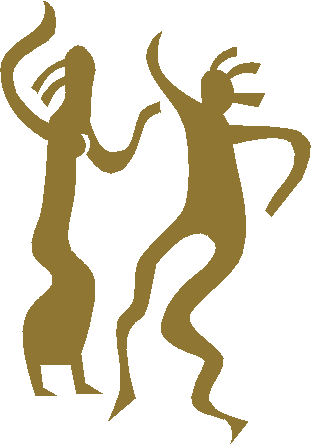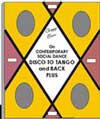| RUMBA
 The Rumba preceded the Mambo and the
Cha-Cha-Cha by a few years as a ballroom dance in the late 1920s and early 1930s. It
turned out to be too difficult a dance for the amateur social dancer that the latter
dances eclipsed it in popularity. Yet the Rumba remains a dancer’s dance, with a
place among the ten dances in the international dance competitions. The Rumba preceded the Mambo and the
Cha-Cha-Cha by a few years as a ballroom dance in the late 1920s and early 1930s. It
turned out to be too difficult a dance for the amateur social dancer that the latter
dances eclipsed it in popularity. Yet the Rumba remains a dancer’s dance, with a
place among the ten dances in the international dance competitions.
Origins
No one is
quite sure where the Rumba actually originated, but rhythmic analysts declare that the
dance more likely was created by the African slaves who were brought under the influence
of the Spanish colonizers.
The Rumba, just like the now-forgotten Son, was a
combination of the color and temperament of Spain with the powerful movement and rhythm
of African Jazz. The real Rumba remains pure West African in every way except the melody.
The double hip movement of the Rumba, completed in two and a half beats, is a highly
complicated basic dance rhythm transported unadulterated from a tribe of Southern Nigeria.
Music and Timing
The Rumba has
a fascinating rhythm and music written in 2/4 or 4/4 time. The complete rhythmic pattern
is composed of double-single-double-single rhythm units. and consists of 8 beats of music.
Basic music tempo averages 27 bars per minute, though the range can be from 24 to 44 bars
per minute. If the music is slow, the dancer will be dancing Open Rumba or
Mambolero.
If the tempo is Mambo, then the dance is Mambo.
The counting is similar to the
Cha-Cha-Cha where the dancer “breaks on two”. (Refer to the Cha-Cha-Cha
chapter on music and timing.) The dancer makes the actual foot movements only on Counts 2 3 4 and
6 7 8. Pause on Counts 5 and 1.
The Hold
The Closed Hold used in the Samba, Mambo and Cha-Cha-Cha is
the same for the Rumba. The body is held naturally upright with the shoulders relaxed. The
weight of the body is kept mainly on the soles of the feet.
The Open Hold is a position in which
the Lady and the Man are apart and facing each other, the Man holding the Lady’s
right hand in his left hand, with arms just above waist level and not quite straight at
the elbow. The Lady’s arm should remain relaxed and her left hand should not be lower
than waist level, and should always be ready to return comfortably to the Man’s right
shoulder when he wishes to regain normal hold.
In the Fan Position, the Lady and the Man are apart,
holding as in Open Hold. The Lady is on the left side and slightly in front of the Man, at
right angle with him. Her left foot is back. The Man has his feet apart with his weight on
the right foot.
Footwork
All the steps are danced on the ball of the foot first, immediately
lowering softly on the flat of the foot. Heel leads are never used. This distinctive
footwork can be achieved with a mastery of body flight.
Leading
The leading
should be firm but light, and only when changing from one figure to another. The Lady,
having received the lead for a figure, should dance the remainder on her own, particularly
in movements where she is in Open Hold.
Hip Movement
A very slight lateral movement of the hips on Counts 4-5
and 8-1 of most basic figures characterizes the Rumba. This occurs because the full weight
of the body is not immediately transferred to the foot on Counts 4 and 8, and the step is
taken on a relaxed knee. As full body weight is taken in the leg on Counts 1 and 5, the
knee straightens and the other knee relaxes.
This results in a very slight and very subtle swing of the
hips. The hip swing should not be stressed and made obvious, and is mostly a feeling the
dancer experiences through the relaxing and straightening of the knees. The straightening
should be soft and the knees must never be fully braced.

|
Learn more about the
Universal Unit System from Ms. Skippy Blair's
DISCO
TO TANGO and BACK PLUS

|
